AWM41 1035 - [Nurses Narratives] Sister Scanlan
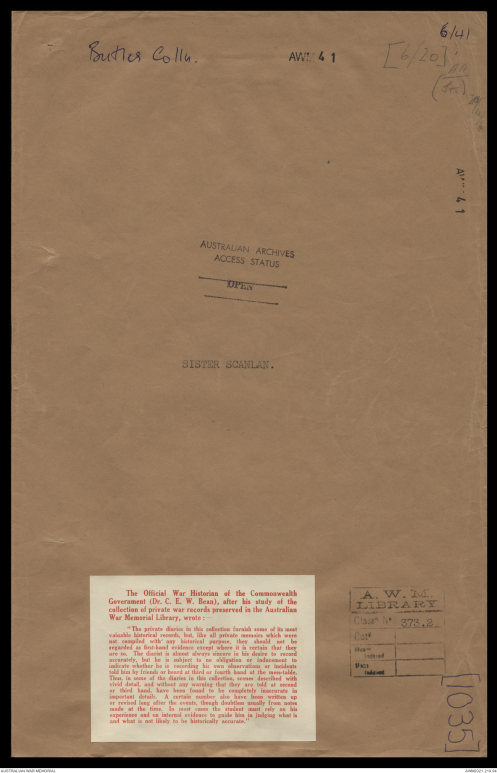
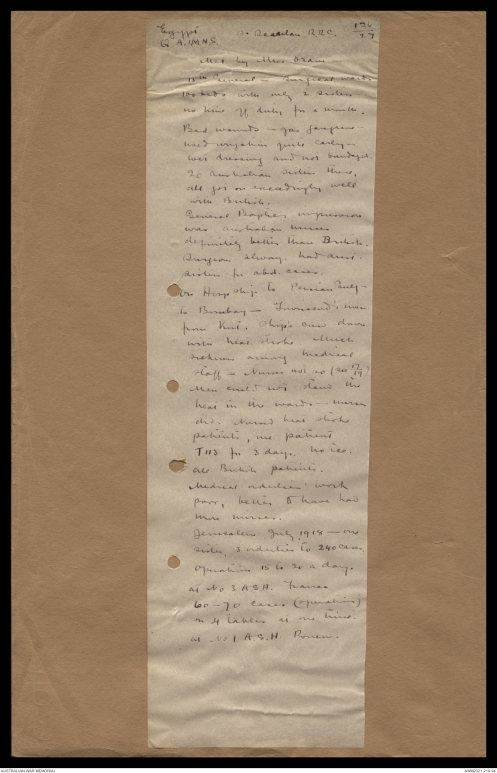
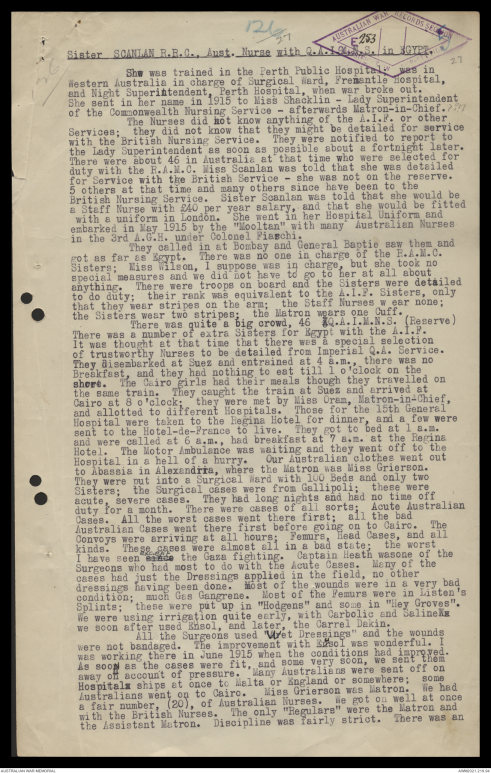
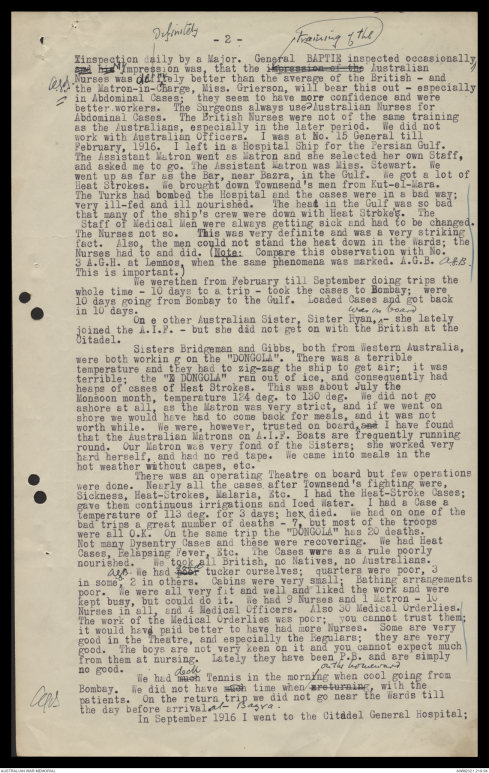
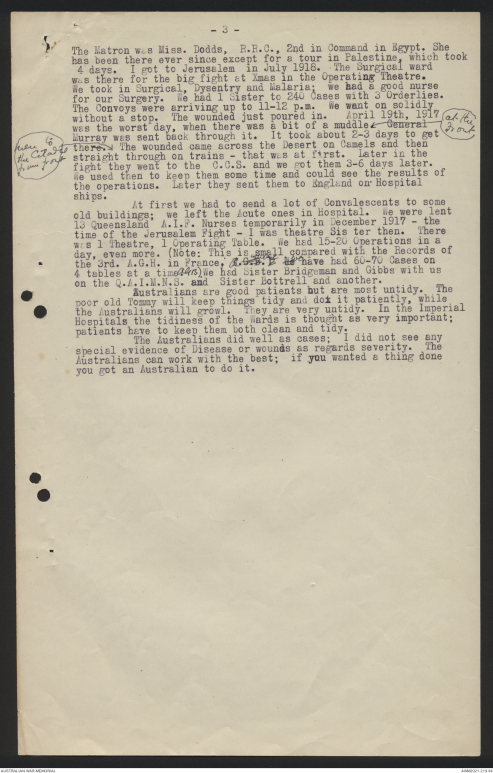
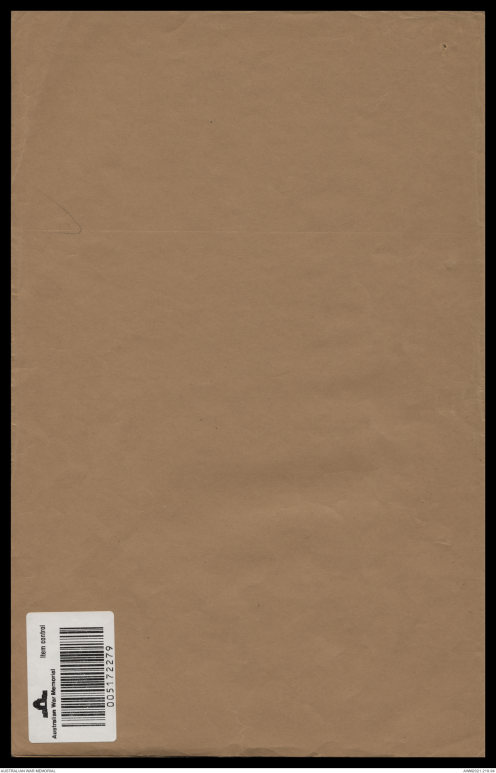
6/41
Butler Colln AWM41 [6/20]
AA/([[?Srs]])
AWM41
AUSTRALIAN ARCHIVES
ACCESS STATUS
OPEN
SISTER SCANLAN.
A.W.M.
Library
Class No 373.2
[1035]
The Official War Histories of the Commonwealth
Government (Dr. C. E. W. Bean), after his study of the
collection of private war records preserved in the Australian
War Memorial Library, wrote :-
"The private diaries in this collection furnish some of its most
valuable historical records, but like all private memoirs which were
not compiled with any historical purpose, they should not be
regarded as first-hand evidence except where it is certain that they
are so. The diarist is almost always sincere in his desire to record
accurately, but he is subject to no obligation or inducement to
indicate whether he is recording his own observation or incidents
told him by friends or heard at third or fourth hand heard at the mess-table.
Thus, in some of the diaries in this collection, scenes described with
vivid detail, and without any warning that they are told at second
or third hand have been found to be completely inaccurate in
important details. A certain number have been written up
or reviewed long after the events, though doubtless usually from notes
made at the time. In most cases the student must rely on his
experience and on internal evidence to guide him in judging what is
and what is not likely to be historically accurate."
"Egypt" Sr Scanlan R.R.C. [*126/27*]
Q.A.I.M.N.S.
Met by Miss Oram
13th General - surgical wards
100 beds with only 2 Sisters
no time off duty for a month
Bad wounds - gas gangrene -
used irrigation quite early
over dressing and not bandaged
20 Australian sisters there,
all got on exceedingly well
with British.
General Baptie's impression
was Australian Nurses
definitely better than British
Surgeons always had Aust
Sisters for abd. cases.
On Hosp ship to Persian Gulf -
to Bombay - Townsend's men
from Kui. Ship's crew down
with heat stroke. Much
sickness among medical
staff - Nurses not so [[see 17/19?]]
Men could not stand the
heat in the wards - nurses
did. Nursed heat stroke
patients, one patient
T113 for 3 days. No ice.
All British patients
Medical orderlies work
poor, better I have had
more nurses.
Jerusalem July 1918 - one
sister, 3 orderlies to 240 cases
Operations 15 to 20 a day.
at No 3 A.G.H. France
60-70 cases (operations)
on 4 tables at one time
at No 1 A.G.H. Rouen.
126/27
E253
[*136*] [*27*]
Sister SCANLAN R.R.C., Aust. Nurse with Q.A.I.M.N.S. in EGYPT.
She was trained in the Perth Public Hospital; was in
Western Australia in charge of Surgical Ward, Fremantle Hospital,
and Night Superintendent, Perth Hospital, when war broke out.
She sent her name in 1915 to Miss Shacklin - Lady Superintendent
of the Commonwealth Nursing Service - afterwards Matron-in-Chief. [*???*]
The nurses did not know anything of the A.I.F. or other
Services; they did not know that they might be detailed for service
with the British Nursing Service. They were notified to report to
the Lady Superintendent as soon as possible about a fortnight later.
There were about 46 in Australia at that time who were selected for
duty with the R.A.M.C. Miss Scanlan was told she was detailed
for Service with the British Service - she was not on the reserve.
5 others at that time and many others since have been to the
British Nursing Service. Sister Scanlan was told she would be
a Staff Nurse with £40 per year salary, and that she would be fitted
with a uniform in London. She went in her Hospital Uniform and
embarked in May 1915 by the "Mooltan" with many Australian Nurses
in the 3rd A.G.H. under Colonel Fiaschi.
They called in at Bombay and General Baptie saw them and
got as far as Egypt. There was no one in charge of the R.A.M.C.
Sisters; Miss Wilson, I suppose was in charge, but she took no
special measures and we did not have to go to her at all about
anything. There were troops on board and the Sisters were detailed
to do duty; their rank was equivalent to the A.I.F. Sisters, only
that they wear stripes on the arm; the Staff Nurses wear none;
the Sisters wear two stripes; the Matron wears one Cuff.
There was quite a big crowd, 46 XQ.A.I.M.N.S. (Reserve)
There was a number of extra Sisters for Egypt with the A.I.F.
It was thought at that time that there was a special selection
of trustworthy Nurses to be detailed from Imperial Q.A. Service.
They disembarked at Suez and entrained at 4 a.m., there was no
Breakfast, and they had nothing to eat until 1 o'clock on the
shore. The Cairo girls had their meals though they travelled on
the same train. They caught the train at Suez and arrived at
Cairo at 8 o'clock; they were met by Miss Oram, Matron-in-Chief,
and allotted to different Hospitals. Those for the 15th General
Hospital were taken to the Regina Hotel for dinner, and a few were
sent to the Hotel-de-France to live. They got to bed at 1 a.m.
and were called at 6 a.m., had breakfast at 7 a.m. at the Regina
Hotal. The Motor Ambulance was waiting and they went off to the
Hospital in a hell of a hurry. Our Australian clothes went out
to Abassia in Alexandria, where the matron was Miss Grierson.
They were put into a Surgical Ward with 100 Beds and only two
Sisters; the Surgical cases were from Gallipoli; these were
acute, severe cases. They had long nights and no time off
duty for a month. There were cases of all sorts; Acute Australian
Cases. All the worst cases went there first; all the bad
Australian Cases went there first before going on to Cairo. The
Convoys were arriving at all hours; Femurs, Head Cases, and all
kinds. These cases were almost all in a bad state; the worst
I have seen since except the Gaza fighting. Captain Heath wasone of the
Surgeons who had most to do with the Acute Cases. Many of the
cases had just the Dressings applied in the field, no other
dressings having been done. Most of the wounds were in a very bad
condition; much Gas Gangrene. Most of the Femurs were in Listen's
Splints; these were put up in "Hodgens" and some in "Hey Groves".
We were using irrigation quite early, with Carbolic and Salinexx
we soon after used Ensol, and later, the Carrel Dakin.
All the Surgeons used "Wet Dressings" and the wounds
were not bandaged. The improvement with Ensol was wonderful. I
was working there in June 1915 when the conditions improved.
As soon as the cases were fit, and some very soon, we sent them
away on account of pressure. Many Australians were sent off on
Hospitalx ships at once to Malta or England or somewhere; some
Australians went on to Cairo. Miss Grierson was Matron. We had
a fair number, (20), of Australian Nurses. We got on well at once
with the British Nurses. The only "Regulars" were the Matron and
the Assistant Matron. Discipline was fairly strict. There was an
- 2 -Xinspection daily by a Major. General BAPTIE inspected occasionallyand his my impression was, that the training of the impression of the Australian
Nurses was defftely definitely better than the average of the British – and
[[*?]]the Matron-in-Charge, Miss Grierson, will bear this out - especially
in Adominal Cases; they seem to have more confidence and were
better workers. The Surgeons always used Australian Nurses for
Abdominal Cases. The British Nurses were not of the same training
as the Australians, especially in the later period. We did not
work with Australian Officers. I was at No. 15 General till
February, 1916. I left in a Hospital Ship for the Persian Gulf.
The Assistant Matron went as Matron and she selected her own staff,
and asked me to go. The Assistant Matron was Miss. Stewart. We
went up as far as the Bar, near Bazra, in the Gulf. We got a lot of
Heat Strokes. We brought down Townsend's men from Kut-el-Mara.
The Turks had bombed the Hospital and the cases were in a bad way;
very ill-fed and ill nourished. The heat in the Gulf was so bad
that many of the ship's crew were down with Heat Strokes. The
Staff of Medical Men were always getting sick and had to be changed.
The Nurses not so. This was very definite and was a very striking
fact. Also, the men could not stand the heat down in the Wards; the
Nurses had to and did. (Note: Compare this observation with No.
3 A.G.H. at Lemnos, when the same phenomena was marked. A.G.B. [*A.E.B.*]
This is important.)
We werethen from February till September doing trips the
whole time - 10 days to a trip - took the cases to Bombay; were
10 days going from Bombay to the Gulf. Loaded Cases and got back
in 10 days.
One other Australian Sister, Sister Ryan, was on board - she lately
joined the A.I.F. - but she did not get on with the British at the
Citadel.
Sisters Bridgeman and Gibbs, both from Western Australia,
were both working on the "DONGALA". There was a terrible
temperature and they had to zig-zag the ship to get air; it was
terrible; the "X DONGOLA" ran out of ice, and consequently had
heaps of cases of Heat Strokes. This was about July the
Monsoon month, temperature 124 deg. to 130 deg. We did not go
ashore at all, as the Matron was very strict, and if we went on
shore we would have to come back for meals, and it was not
worth while. We were, however, trusted on board.and I have found
that the Australian Matrons on A.I.F. Boats are frequently running
round. Our Matron was very fond of the Sisters; she worked very
hard herself, and had no red tape. We came into meals in the
hot weather without capes, etc.
There was an operating Theatre on board but few operations
were done. Nearly all the cases after Townsend's fighting were,
Sickness, Heat-Strokes, Malaria, Etc. I had the Heat-Stroke Cases;
gave them continuous irrigations and Iced Water. I had a Case a
temperature of 113 deg. for 3 days; hex died. We had on one of the
bad trips a great number of deaths - 7, but most of the troops
were all O.K. On the same trip the "DONGOLA" has 20 deaths.
Not many Dysentry Cases and these were recovering. We had Heat
Cases, Relapsing Fever, Etc. The Cases were as a rule poorly
nourished. We took all British, no Natives, no Australians.
[*A.E.B.*] We had poor good tucker ourselves quarters were poor, 3
in some, 2 in others. Cabins were very small; Bathing arrangements
poor. We were all very fit and well and liked the work and were
kept busy, but could do it. We had 9 Nurses and 1 Matron - 10
Nurses in all, and 4 Medical Officers. Also 30 Medical Orderlies.
The work of the Medical Orderlies was poor; you cannot trust them;
it would have paid better to have had more Nurses. Some are very
good in the Theatre, and especially the Regulars; they are very
good. The biys are not very keen on it and you cannot expect much
from them at nursing. Lately they have been P.B. and are simply
no good.
We had much deck Tennis in the morning when cool going from
Bombay. We did not have much time when xreturning, on the homeward with the
[*?*] patients. On the return trip we did not go near the Wards till
the day before arrival at Bazra.
In September 1916 I went to the Citadel General Hospital;
- 3 -
The Matron was Miss. Dodds, R.R.C., 2nd in Command in Egypt. She
has been there ever since except for a tour in Palestine, which took
4 days. I got to Jerusalem in July 1918. The Surgical ward
was there for the big fight at Xmas in the Operating Theatre.
We took in Surgical, Dysentry and Malaria; we had a good nurse
for our Surgery. We had 1 Sister to 240 Cases with 3 Orderlies.
The Convoys were arriving up to 11-12 p.m. We went on solidly
without a stop. The wounded just poured in. April 19th, 1917
was the worst day, when there was a bit of a muddle at the Front. General
Murray was sent back through it. It took about 2-3 days to get
there. [*men to the Citadel from Front*] The wounded came across the Desert on Camels and then
straight through on trains - that was at first. Later in the
fight they went to the C.C.S. and we got them 3-6 days later.
We used then to keep them some time and could see the results of
the operations. Later they sent them to England on Hospital
ships.
At first we had to send a lot of Convalescents to some
old buildings; we left the Acute ones in Hospital. We were lent
13 Queensland A.I.F. Nurses temporarily in December 1917 - the
time of the Jerusalem Fight - I was theatre Sister then. There
was 1 Theatre, 1 Operating Table. We had 15-20 Operations in a
day, even more. (Note: This is small compared with the Records of
the 3rd. A.G.H. in France. [[?]] We we have had 60-70 Cases on
4 tables at a time.)[*A.E.B.*] We had Sister Bridgeman and Gibbs with us
on the Q.A.I.M.N.S. and Sister Bottrell and another.
Australians are good patients but most untidy. The
poor old Tommy will keep things tidy and dox it patiently, while
the Australians will growl. They are very untidy. In the Imperial
Hospitals the tidiness of the Wards is thought as very important;
patients have to keep them both clean and tidy.
The Australians did well as cases; I did not see any
special evidence of Disease or wounds as regards severity. The
Australian can work with the best; if you want a thing done
you got and Australian to do it.
Item control
Australian War Memorial
Barcode - see original.
005172279
 Sam scott
Sam scottThis transcription item is now locked to you for editing. To release the lock either Save your changes or Cancel.
This lock will be automatically released after 60 minutes of inactivity.